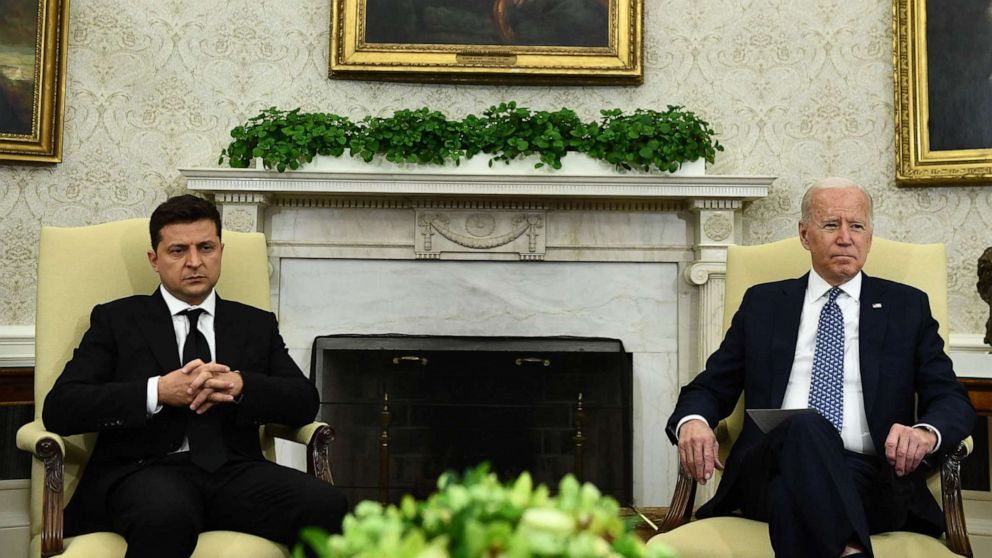As the U.S. continues to warn that the threat of a Russian attack on Ukraine remains “imminent,” there is one dissenting voice that has grown stronger — Ukraine’s.
From President Volodymyr Zelenskyy down, the Ukrainian government has tried to urge calm, with senior officials making clear in recent days they don’t see the risks now as any more heightened than over the last eight years of Russian-stoked conflict in eastern Ukraine.
Ukrainian Deputy Foreign Minister Hanna Malyar, for example, said the number of Russian troops massed on Ukraine’s borders “are not enough for a full-scale invasion.” Instead, Russian leader Vladimir Putin is using the troop build-up “primarily to politically blackmail the West and pressure Ukraine,” she wrote in a Facebook post.
“Russia’s tactical goal is provoke integral divisions in our society, sew fear and panic, to destabilize the internal situation,” she added.
Ukrainian concern that fear and panic could spread, sending Ukraine’s economy spiraling or creating political turmoil, has started to create divisions between the U.S. and Ukraine — despite efforts on both sides to make clear they stand united against any Russian aggression.
“All is under control. There are no reasons to panic,” Zelenskyy said in a televised address to his country Monday night — but the speech spent more time on COVID-19 than Russia.
Some of the steps the U.S. has taken in recent days, some in Kyiv fear, are playing into Moscow’s playbook — stoking fear and panic.
That includes the State Department’s decision to draw down the U.S. embassy, ordering diplomats’ families to evacuate and authorizing non-emergency staff to depart if they choose.
State Department spokesperson Ned Price called it a “prudent precaution,” but his Ukrainian counterpart, Ministry of Foreign Affairs spokesperson Oleg Nikolenko. criticized it as “a premature one and an instance of excessive caution.”
“The Russian Federation is currently taking active efforts to destabilize the situation in Ukraine. A large amount of misinformation, manipulation, and fakes are spreading in Ukrainian and international media in order to cause panic among Ukrainians and foreigners, intimidate business, and undermine the economic and financial stability of our state. In this situation, it is important to soberly assess the risks and stay calm,” Nikolenko added.
Just four countries have followed the U.S., to varying degrees — the United Kingdom, Australia, Canada and Germany.
“If people cross into a state of panic, that is a dangerous situation for our country, and it will be far easier to then manipulate us, and that is Russia’s goal,” warned Aleksey Danilov, a top Ukrainian national security official.
Some economic damage is already apparent. Yields on Ukrainian sovereign Eurobonds in U.S. dollars suddenly shot up to 11-14% on Jan. 14 and have risen even higher since — losing Ukraine access to the international financial market, according to Anders Åslund, a senior fellow at the Stockholm Free World Forum.
“Ukraine’s emerging economic problems are entirely due to the shadow cast by the threat of a dramatic escalation in Russian military aggression,” Åslund wrote for the Atlantic Council, a Washington-based think tank.
The White House and State Department defended the administration’s decisions and rhetoric, denying that drawing down the embassy, putting 8,500 U.S. troops on alert, and warning of an “imminent” threat have escalated the situation.
“I will let others assess, but there are 100,000 troops — Russian troops — on the border of Ukraine and no clarity that the leader of Russia doesn’t intend to invade. That sounds pretty dangerous to me,” White House press secretary Jen Psaki said Tuesday.
But 100,000 is not enough for an invasion, according to Malyar and the top commander for Ukraine’s forces on the frontlines. Lt. Gen. Oleksander Pavlyuk told ABC News last week that Ukraine had assessed Russian had 127,000 troops in total, although the U.S. still says approximately 100,000. Either way, Ukraine’s own army is approximately 200,000 strong now, and many more Russian troops would be needed to invade a country the size of Texas.
The number of Russian troops is also “not increasing in the way that today many are representing,” said Danilov, who serves as secretary of Ukraine’s national security council, told the BBC in an interview Tuesday. “Is it unpleasant for us? Yes, but for us, it’s not news. If for someone in the West that has become news, well, I’m sorry.”
Still, Psaki denied there was daylight between Washington and Kyiv, adding, “We are in constant contact with Ukrainians to reiterate our support, to convey updates on shipments of supplies, military equipment — something that’s been happening over the last several days.”
Nikolenko too highlighted that military cooperation, praising “its proactive diplomatic position and for strengthening Ukraine’s defense capabilities, including the provision of weapons and equipment.”
ABC News’s Patrick Reevell contributed to this report from Kyiv, Ukraine.

